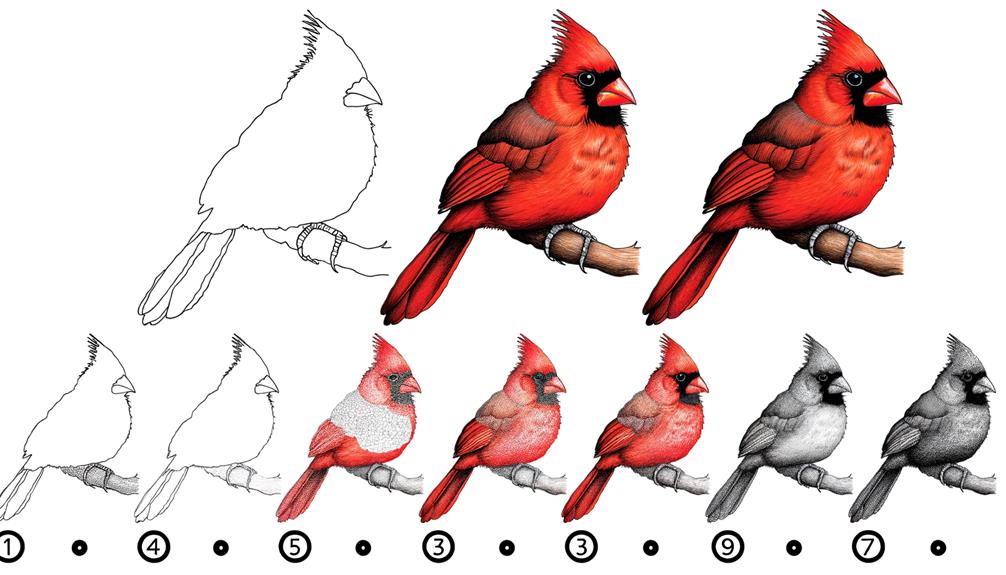7 Simple Steps to Draw a Cardinal Bird
To draw a cardinal bird, begin with high-quality drawing paper, graphite pencils (2H to 6B), a kneaded eraser, and a fine-tipped ink pen. Start by sketching basic shapes: a circle for the head, an oval for the body, and curved lines connecting them.
Draw an oval shape for the head and a triangle for the beak. Add guidelines for the eyes and the black facial mask.
Sketch the legs beneath the body, add claws, and draw the medium-sized tail with varying line lengths. Progress by refining feather textures and incorporating shading for depth.
Continue to discover intricate details and final touches.

Key Takeaways
- Begin with simple circles for the head and body, connected by curved lines to form a basic outline.
- Draw an oval shape for the head and a triangular beak, adding guidelines for eye placement.
- Sketch the legs with proportional length and natural stance, ensuring joints and claws are detailed.
- Add feather texture with small, overlapping lines, following the natural plumage direction.
- Use varying pencil grades for shading and highlights to enhance depth and realism.
Gather Your Materials
To begin your journey in drawing a cardinal bird, gather essential materials including high-quality drawing paper, a set of graphite pencils ranging from 2H to 6B, a kneaded eraser, and a fine-tipped ink pen for detailing.
Start with your drawing paper, selecting a smooth surface to guarantee clean lines. Use the 2H pencil to sketch the initial outline lightly, allowing for easy adjustments. Gradually shift to softer pencils like 4B and 6B for shading and texture, adding depth to your drawing.
The kneaded eraser will help you refine highlights and correct mistakes without damaging the paper.
Study Cardinal Anatomy
Understanding the anatomy of a cardinal bird is essential for capturing its distinctive features accurately in your drawing. Begin by observing the cardinal's body structure: its stout, rounded body, and medium-sized tail. Note the prominent crest on its head, which peaks sharply, adding to its characteristic silhouette.
Examine the bird's facial features, focusing on the black mask around its beak and eyes, contrasting vividly with its bright red plumage. Pay attention to the robust, conical beak, ideal for cracking seeds. Study the wings and their feather patterns, noting how they fold against the body.
Outline Basic Shapes
Begin by sketching two simple circles: one for the head and a larger one for the body.
Next, connect these circles with smooth, curved lines to define the neck and overall body proportions.
This foundational outline will serve as a guide for refining the cardinal bird's shape and adding more intricate details.
Sketch Simple Circles
Start by lightly sketching two overlapping circles, with the larger one forming the body and the smaller one representing the head of the cardinal bird. Utilize smooth, gentle strokes to make sure that the circles maintain a delicate and refined appearance. Make sure that the circles overlap slightly to create a natural and cohesive shape for the bird's silhouette. This foundational step is essential for achieving the correct proportions and fluidity in your drawing. The table below assists in visualizing the emotional connection to this process:
| Step | Emotion |
|---|---|
| 1 | Anticipation |
| 2 | Calmness |
| 3 | Satisfaction |
Define Body Proportions
To define the body proportions of the cardinal, carefully outline the primary shapes that constitute its form, using the circles as a guide to sketch the torso, head, and tail. Begin by connecting the circles with smooth lines to form the bird's body. Make sure that the head is proportionate to the torso, typically about one-third its size. The tail will extend from the lower part of the torso, tapering into a sleek, elongated shape.
To visualize this process, follow these steps:
- Torso: Draw an oval connecting the largest circle with the head's circle.
- Head: Sketch a smaller oval overlapping the top of the torso.
- Tail: Extend a long, narrow triangle from the lower circle of the torso.
These foundational shapes will guide the detailed sketching.
Draw the Head
Using a light pencil, sketch an oval shape to represent the cardinal's head, making certain it is proportionate to the body outline. Position the oval slightly above the center of the body, maintaining a smooth connection to the neck area. Pay attention to the size; it should be large enough to house the bird's facial features yet harmonize with the overall structure.
Next, lightly draw a guideline through the middle of the oval, both vertically and horizontally, to help place the eyes and other features accurately. The horizontal line will guide eye placement, while the vertical line guarantees symmetry.
Carefully refine the shape, adding gentle curves to depict the fullness of the cardinal's head, preparing for subsequent detailing.
Sketch the Beak
Begin by drawing a small triangular shape at the lower part of the cardinal's head, ensuring it aligns with the vertical guideline for symmetrical placement. This triangular form will serve as the basic outline of the beak.
The beak of a cardinal is distinctive and should be depicted with sharp, clean lines to capture its characteristic shape.
To achieve accuracy, follow these steps:
- Define the Upper Beak: Extend a slightly curved line from the top of the triangle, forming the upper beak.
- Create the Lower Beak: Draw a shorter, curved line beneath the triangle to form the lower beak, ensuring it appears proportionate.
- Add Details: Refine the edges and add subtle lines to depict the natural texture and curvature of the beak.
Add the Body
To begin adding the body of the cardinal, start by outlining the main shape, ensuring it flows naturally from the head and beak.
Next, define the proportions by sketching the overall size and position of the body in relation to the head.
Outline the Main Shape
With a light pencil stroke, sketch an oval shape to represent the cardinal bird's body, ensuring it is slightly tilted to capture the bird's natural posture. This initial shape will serve as the foundation for your drawing.
To achieve accuracy, follow these steps:
- Angle: Tilt the oval slightly to the right or left, reflecting the bird's typical stance.
- Proportion: Keep the oval elongated but not too narrow; it should be balanced to accommodate further details.
- Placement: Position the oval centrally on your paper, allowing space for the head, tail, and wings.
Define the Proportions
Next, draw a smaller circle atop the oval to represent the cardinal bird's head. Make sure the circle intersects the top part of the oval slightly to establish a natural connection between the head and the body. This intersection helps to visualize the bird's neck area, creating a seamless flow.
Now, draw a curved line from the bottom of the head circle to the lower edge of the oval, forming the back of the cardinal. From the lower part of the head circle, sketch another curved line connecting to the lower edge of the oval, outlining the bird's chest. Make certain these lines are smooth to mimic the bird's natural contours.
This framework accurately defines the cardinal's proportions and sets the stage for further detailing.
Add Feather Details
Begin by sketching small, overlapping curves along the bird's back and chest to simulate the texture of feathers, ensuring each curve follows the natural contours established in the previous step. This attention to detail will enhance the realism of your drawing.
Focus on the following key areas:
- Back Feathers: Draw elongated curves that taper towards the tail, giving the impression of sleek, layered feathers.
- Chest Feathers: Use shorter, rounded curves to depict the softer, fluffier texture of the chest area.
- Wing Feathers: Extend the wing's form by adding distinct, pointed feather shapes that overlap slightly, emphasizing their layered structure.
Define the Wings
To define the wings, carefully outline the primary feathers by drawing a series of long, curved lines extending from the bird's body, making sure they fan out symmetrically.
Begin by sketching a smooth arc starting from the bird's shoulder, tapering outward. Draw each feather with a gentle curve, varying slightly in length to create a natural look. Position these feathers so they overlap slightly, mimicking how real feathers layer. Pay attention to spacing; the feathers should be closely packed near the shoulder, gradually spreading out.
Add secondary feathers beneath the primary ones, using shorter, softer lines. Confirm these secondary feathers align with the curve of the wing, providing additional depth and realism to your cardinal bird drawing.
Create Tail Feathers
From the base of the cardinal's body, extend a series of straight, elongated lines downward and slightly outward to form the central tail feathers, making sure they taper to gentle points at the ends. These lines should vary slightly in length to create a natural, layered effect.
Next, add additional feathers on either side of the central feathers, slightly curving them to follow the contour of the bird's body.
To achieve a more realistic appearance, follow these steps:
- Vary Line Lengths: Make sure the central feathers are the longest, with adjacent feathers gradually decreasing in length.
- Add Texture: Lightly sketch short, curved lines along each feather to replicate the natural texture.
- Refine Edges: Carefully refine the edges of each feather to maintain a smooth, cohesive look.
Draw the Legs
To accurately illustrate the legs of your cardinal, begin by positioning them at an appropriate angle beneath the bird's body, typically aligned with the lower portion of the torso.
Next, sketch the basic shape of the legs, ensuring they are proportional to the bird's size and lightly curved to mimic a natural stance.
Position the Legs Correctly
Carefully observe the reference image of the cardinal bird, noting the natural bend and placement of its legs to guarantee anatomical precision in your drawing.
The legs of the cardinal should be positioned to reflect the bird's natural stance and balance. To position the legs correctly, follow these steps:
- Identify the Joint Angles: Notice how the leg bends at the knee and ankle joints, creating a lifelike pose.
- Align with the Body: Confirm the legs are aligned properly with the bird's body, maintaining proportion and symmetry.
- Foot Placement: Accurately place the feet where they naturally grip the perch or ground, paying attention to the spacing and angle.
These steps help maintain the natural posture of the cardinal.
Sketch Basic Leg Shape
With the correct positioning in mind, begin sketching the basic leg shape by outlining the primary contours of each leg, ensuring to reflect the natural bends observed in the reference image.
Start by drawing thin, slightly curved lines to represent the upper and lower segments of the legs. The upper leg, or thigh, should be thicker and gradually taper down to the knee joint.
From the knee, extend the lower leg, which should also taper slightly as it progresses toward the foot. Pay attention to the subtle angles and curves that give the leg a lifelike appearance.
Make sure both legs are symmetrical and proportionate to the bird's body, as accurate proportions are essential for realism.
Add Claws and Details
Next, refine the legs by adding claws and intricate details that capture the natural texture and anatomy of the cardinal's feet. Begin by sketching the three forward-facing toes and a single backward-facing toe. Confirm the toes are proportional and slightly curved to reflect the bird's grasping ability. Add subtle lines to represent the scales and joints for a realistic touch.
To create the claws:
- Draw Sharp Tips: Sketch sharp, curved tips at the end of each toe.
- Add Thickness: Thicken the claws near the toes to show strength.
- Detail with Texture: Use fine lines to add texture and definition to the claws.
Add Facial Details
Focus on the cardinal's eye by drawing a small, dark circle slightly above the beak, making sure it is positioned symmetrically on the head. Extend a thin, curved line from the top of this circle to give the eyelid a natural look. Next, add a small highlight within the circle to create a realistic glint.
Proceed to outline the cardinal's distinctive black mask, starting from the base of the beak and curving around the eye, forming a teardrop shape. Ensure the lines are smooth and symmetrical for accuracy.
Refine Feather Texture
To refine the feather texture, carefully sketch a series of small, overlapping lines along the cardinal's body, ensuring they follow the natural direction of the plumage for a realistic appearance. Begin by lightly drawing short strokes that mimic the feather layers. Concentrate on creating a dense pattern in areas such as the wings and tail, while keeping the lines finer on the head and chest. This will enhance the bird's natural form and depth.
Here are three key steps:
- Direction: Follow the curvature of the bird's body to maintain realism.
- Layering: Gradually build up layers to create a rich, textured effect.
- Variation: Adjust line length and density to reflect different feather types and areas.
This meticulous approach will lend authenticity to your drawing.
Final Touches and Shading
With the feather texture meticulously refined, it's time to enhance your drawing by adding final touches and shading to bring the cardinal bird to life. Begin by identifying the light source, then shade accordingly to create depth. Use softer pencils for shadows and harder pencils for fine details.
| Step | Task | Tools Needed |
|---|---|---|
| 1 | Shade under the beak | 2B pencil, blending stump |
| 2 | Darken the wing edges | 4B pencil |
| 3 | Add highlights to the eyes | Eraser, HB pencil |
| 4 | Emphasize feather overlaps | 2B pencil |
| 5 | Soften progressions in shading | Blending stump |
Pay attention to subtle gradations, ensuring a realistic portrayal of light and shadow.
Conclusion
In sum, mastering the art of drawing a cardinal bird involves a series of meticulous steps:
- Gathering materials
- Studying anatomy
- Outlining shapes
- Refining details such as the head, beak, legs, and feather texture.
According to a study by the National Audubon Society, cardinals are one of the most recognizable and beloved birds in North America, with their population estimated at over 120 million. This statistic underscores the widespread appeal of capturing their likeness through art.






